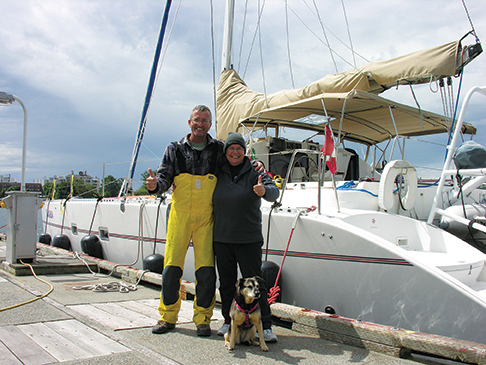Simple massage techniques to improve health and circulation in your favorite four-legged crewmembers (published January 2013)
“Were you successful?”
I ask Tony as he steps out of the dinghy and secures it to the stern of our catamaran.
“Yup,” he replies, but I detect a hesitation in his voice.
“Completely successful?” I persist.
“Nope, only half.” I can see the disappointment in his eyes.
“That’s okay. Maybe we’ll have better luck later today,” I say, trying to bolster his spirits.
One might think that we are talking about a provisioning emergency or an excursion to procure a much-needed boat part. Instead, we are discussing—simply put—our dog’s morning business. Not since my kids were potty training have I been so attuned to another being’s bodily functions. But, that is life with a dog onboard.
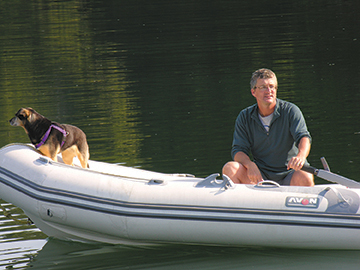
There is no doubt in my mind that our dog, Rizzo, enhances our sailing experience despite the occasional inconvenience of having to tend to her morning and evening toilet. Because of her, we pick moorages that have walks and hiking trails and explore each of them on foot and by kayak. It can be so easy to sit back in the cockpit with a glass of wine, simply enjoying the views. And although that’s often exactly what we think we want to do, Rizzo soon convinces us that getting off the boat is a much more attractive alternative. And she’s pretty much always right.
A DOG’S LIFE
Tony and I love having a dog onboard our 42-foot catamaran, Vakasa. But what does Rizzo think of her sailing life? Well, if she could talk, I’m pretty sure her response would be: “Oh my gosh, the boat! I am queen of the boat! I love the boat!”
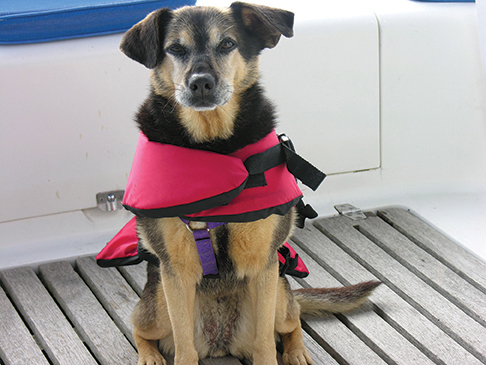
And why wouldn’t she like the boat and sailing life? It has lots of perks. She quite literally lives at the center of our boating universe. Right up there with navigation and anchoring. She gets several walks a day and enjoys free rides in the kayak and dinghy. There is the constant interest of scrutinizing the shore for raccoons and other small animals, and watching the water for playful seals. She gets to eat people food, as I try to minimize garbage. She gets endless cuddles in the cockpit when it’s cool—she’s the perfect substitute for a hot water bottle—and snoozes on the trampoline when it’s warm. People are constantly worried about her needs, and she laps it up.
We’ve found a number of things that make living with a dog onboard easier. After the tags on Rizzo’s collar lodged in the slats of a wooden hatch cover, we removed it in favor of a body harness. The harness also allows us to lift her easily and safely—very helpful when she’s getting on or off the boat or dinghy. She has her own personal floatation device, which we put on her whenever inclement weather strikes. When seas are rough, we have a safe place in the cockpit that she is clipped into via her harness, and if things get really hairy, another place in the saloon to secure her safely out of the way.
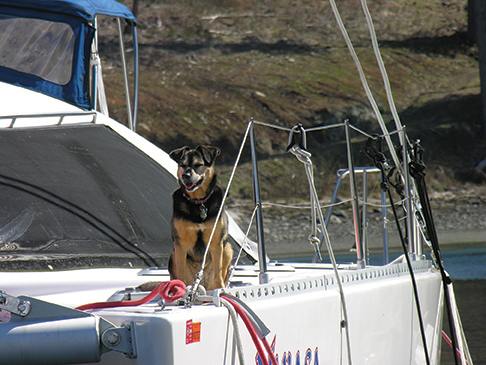
I keep a leather glove handy, and although a sailboat isn’t a very good place to play fetch, we can have a great game of tug-of-war. We use a heavy water bowl, so when we invariably kick it, we don’t spill Rizzo’s water but merely stub our toes. We provide her with multiple rubber-backed rugs, which we place strategically around the cockpit so she has the security of digging her nails into something other than perilous fiberglass. Similarly, we have several dog blankets placed around the saloon so she has her own spaces that aren’t in the way of the rest of the crew. We keep a stack of doggie towels onboard that outnumber our people towels five to one; necessary tools to keep dirty paw prints off Vakasa’s gleaming white deck.
But one of my favorite ways of keeping Rizzo happy and healthy on the boat is to give her regular massages. Animal massage is a fairly new field, but it’s growing quickly because people are starting to view their pets as valued family members. Pet massage is a gentle and non-invasive treatment that significantly adds to an animal’s general health and well-being. In a boating environment, it can reduce any negative effects that confinement and decreased exercise have on a dog by improving circulation and lymphatic drainage, lowering anxiety, and generally relaxing the mind and body. This form of interaction with a pet also improves the bond between human and animal and has been scientifically proven to extend the life of both parties. So it would seem to be a win/win situation—and just another reward of having a furry four-legged friend onboard.
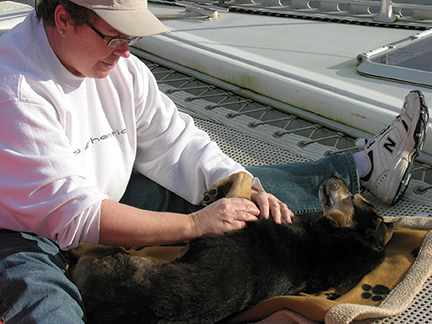 BASIC MASSAGE FOR YOUR SEAFARING DOG OR CAT
BASIC MASSAGE FOR YOUR SEAFARING DOG OR CAT
Here is a very basic massage routine that you can use with your dog or cat. You may want to start out with just two or three of these techniques and gradually increase the scope and length of the massage session as you gain confidence and skill.
Choose a time of day and location that allows both of you to focus, relax and enjoy the experience. Wait until the winds are mild and the boat is stable. I try to use the same location and mat/bed for each massage, as Rizzo quickly learned to associate these things with a massage and relaxes that much faster.
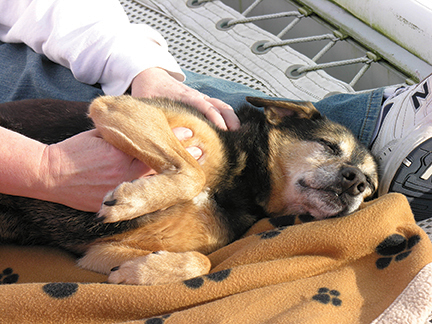 Allow your pet to begin the session in any position. They will often sit to start and gradually relax into a horizontal position. There is no need to restrain them. If the location allows them to get up and move about, let them do so if they want, then gently encourage them to return to the massage area.
Allow your pet to begin the session in any position. They will often sit to start and gradually relax into a horizontal position. There is no need to restrain them. If the location allows them to get up and move about, let them do so if they want, then gently encourage them to return to the massage area.
If the ultimate goal of your massage is relaxation, remember to keep strokes relatively slow, fluid and gentle. Dogs and cats seem to respond best to a reasonably light touch. Regular deep breathing on your part can also enhance the effect of your massage by encouraging your pet to follow suit.
Watch your pet and respond to their feedback. If they appear tense or unsettled by what you’re doing, try lightening your touch or changing techniques completely. By working together you will soon discover which techniques are most effective for your animal.
Your initial massages may only last five minutes. Eventually, depending on how your pet responds to the techniques, you can stretch the length of the massage to 20 or 30 minutes.
TECHNIQUE 1: OPENING STROKES
Start with several long, gentle strokes using a soft, open hand. Run from the top of the head down to the front paws, maintaining contact at all times. Follow this with several similar strokes that start at the head, follow along the back and end at the hind paws. Then do several strokes that start at the head and curve around the body to include the entire stomach. These strokes help improve general circulation, move body wastes and warm the tissues in preparation for the rest of the massage. This step also helps cue the animal that a massage is underway and familiarizes the massager with the physical and emotional state of the animal.
TECHNIQUE 2: KNEADING THE NECK
Using the entire hand in a pincher-type grip, gently lift and squeeze the muscles and tissues around the neck. If you have a very small dog you might be limited to using one hand or even just the fingers and thumb of one hand. Begin with gentle pressure and a slow rhythm and then gradually increase the depth and pressure of your squeeze according to your dog’s comfort level. This technique is very similar to that of kneading bread. It helps improve circulation and eliminate waste products by creating a pumping action.
TECHNIQUE 3: CUPPING CHEST & RIB CAGE
Create a loose “cup” with your hand and gently strike around the chest and ribcage with it. The light blow is cushioned by the air trapped in the cup and should make a nice hollow sound. Try a rate of approximately four or five percussions per second. This can help relieve congestion and improve breathing. It is also very relaxing for most animals.
TECHNIQUE 4: SQUEEZING THE LEGS & PAWS
Begin with the large muscles at the top of the legs. Compress these muscles using both hands and hold this for several seconds. You can also add a gentle twist at the end of the compression (think about rotating the muscle around the bone). Then slide your hands a bit further down the leg and repeat. Continue right down to the paw and finish by gently squeezing it. When you reach the lower part of the leg you will probably only need one hand. Do all four legs. This lengthens the muscle fibers and improves blood flow to the muscles involved.
TECHNIQUE 5: COMPRESSING THE BACK
Start on one side of the spinal column (those little bumps that run down the center of the back), up by the shoulder blade. Use the heel of your hand to apply a gentle pressure directly downward into the muscle. Hold this for a moment, then maintaining the pressure, slowly slide slightly further down the side of the back and hold again. Continue all the way down to the tail, stopping every inch or so to apply compression to the muscle at that spot. Repeat several times and then change to the other side of the spinal column. This technique lengthens and separates muscle fibers and helps improve local circulation.
TECHNIQUE 6: DON’T FORGET THE TAIL
This technique is similar to “Neck Kneading,” but uses just your fingers and thumbs. Lift and gently squeeze the muscles all around the base of the tail, lower back and hip region. Again, start with slow and gentle pressure and increase these gradually if your dog enjoys it. This helps relax all the muscles that control the tail.
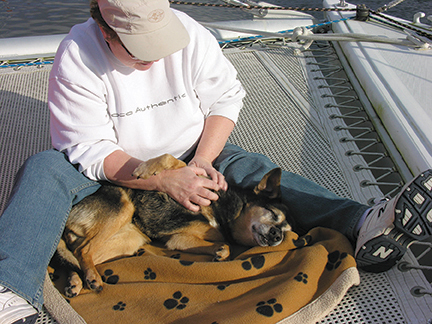
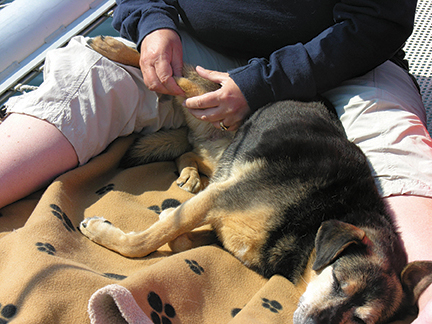
TECHNIQUE 7: CLOSING
It’s always a good idea to reconnect all of the various body parts you’ve been working on by ending your massage with several of the same type of stroke you used at the beginning of the session. This lets your pet know that the massage is now over and terminates the session with a gentle touch.
Once you have mastered these strokes, have fun mixing things up. You can use each of the techniques on different areas of the body with great success. For instance, try cupping over the shoulder or hip joints to improve joint fluidity, kneading the large muscles at the top of the legs to promote circulation, or doing compressions all around the shoulder blade region to release painful adhesions. Just remember to observe your pet and concentrate on techniques that are effective and agreeable to them.
Relax, breathe, and enjoy all the benefits that both you and your dog or cat will gain from sharing a massage at sea!
Kathy Silver is a physiotherapist and Certified Small Animal Massage Practitioner. She and her husband, Tony, along with their faithful canine crew member, Rizzo, have been sailing in the Pacific Northwest on their catamaran, Vakasa, for five years. They have lived aboard for the past two years and headed to Mexico last summer.

















